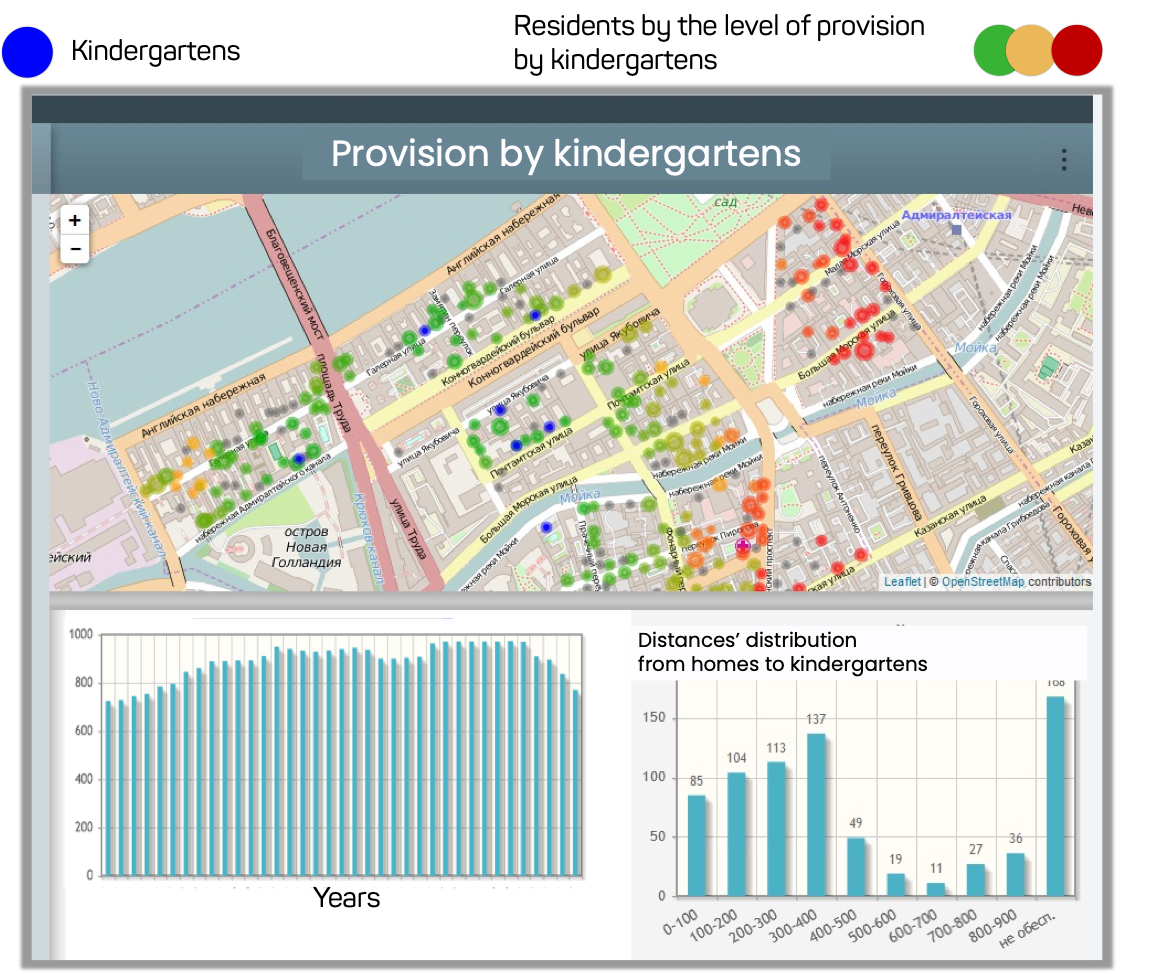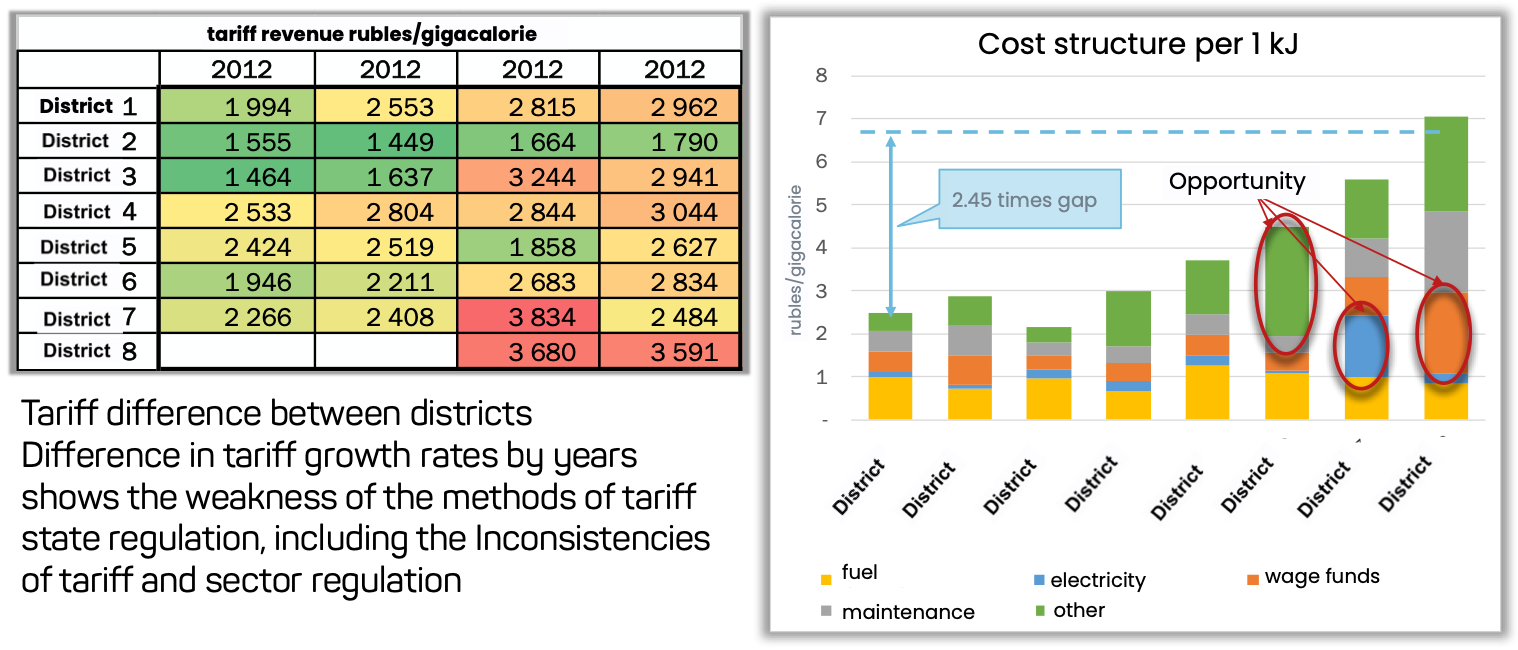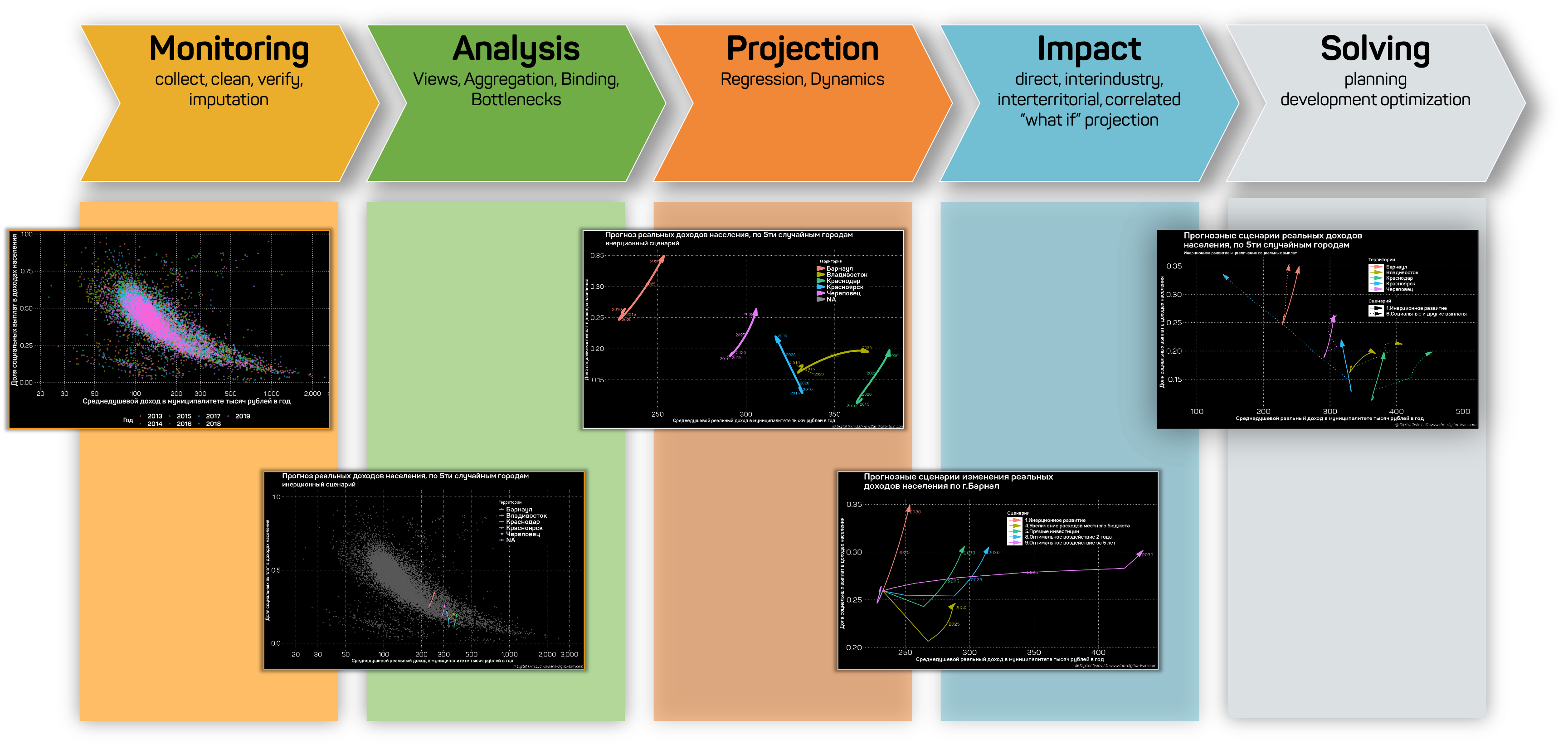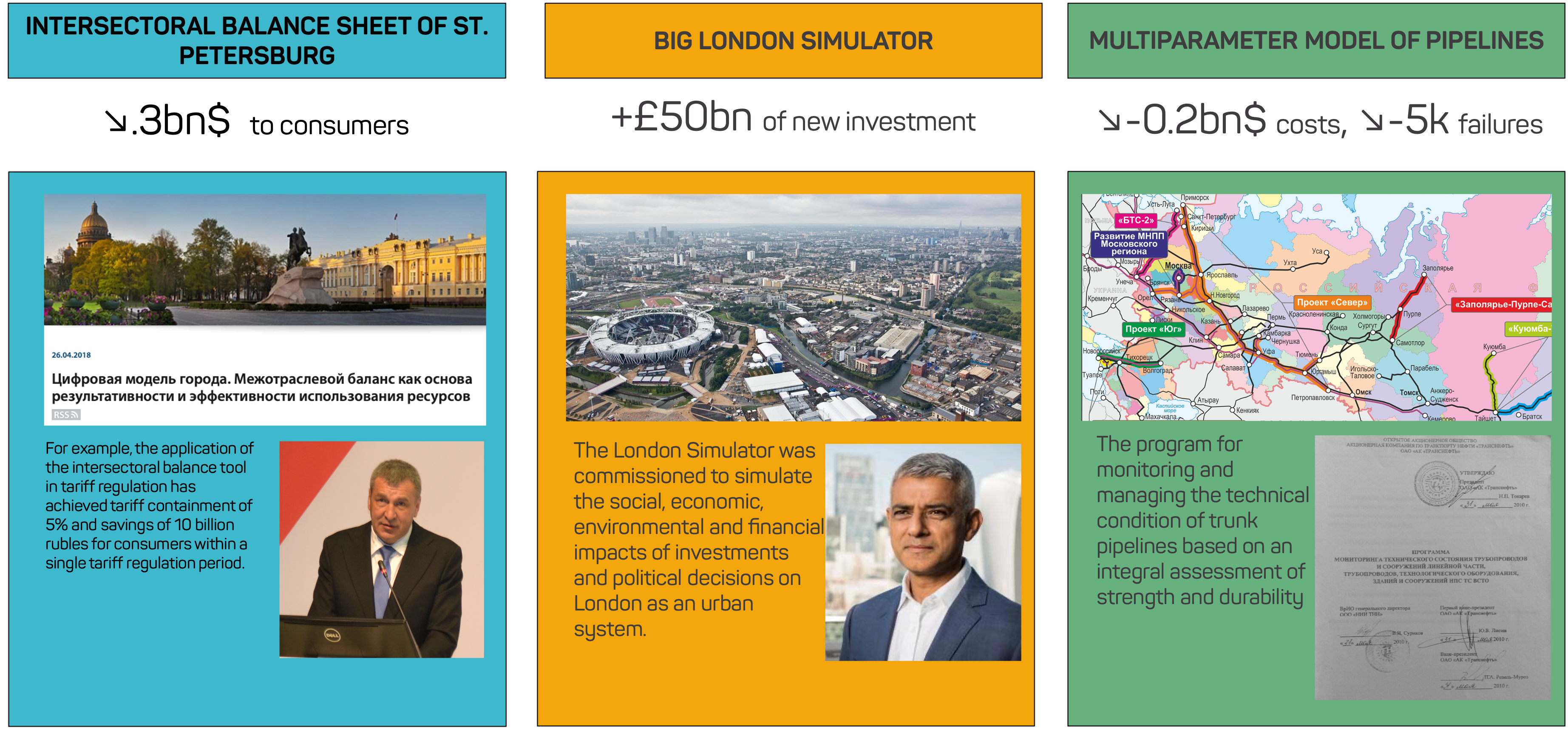3 Basic Terms
Digital Twin is a set of data and mathematical models that allow you to form behavioral estimates of a target system and its environment throughout the life cycle. This data is required for managing the performance and efficiency of the target system.

The place of the Digital Twin in the asset management system
City Digital Twin is a set of indicators characterizing the dynamics of social, economic and natural-anthropogenic development of territories connected by a set of mathematical models. It allows users, without the intervention of an observer, to carry out scenario-based assessments and determine and correct goal achievement programs (or plans) that are optimal in terms of resources.
Intersectoral balance (IB) is an integrated system of indicators characterizing the movement of economic resources through an economic structure (from the spheres of final and domestic consumption to value-added formation and distribution) in the context of types of economic activity, administrative division (interterritorial balance), formed for reporting and forecast periods.
IB model is an econometric model of the intersectoral balance that describes the structural and dynamic relationships of the characteristics of the IB for solving flow problems faced in analysis, forecasting, planning, and impact assessment. The IB model is one of the supporting (balance) models of the City Digital Twin and determines the structural foundations of the economic dynamics of the territory.
The input-output method – as the methodological basis of the IB in City Digital Twin, it can be generalized in terms of socio-economic dynamics and projected onto special cases, including fuel, energy, and interterritorial balances.
3.1 Abbreviations
SED - Social & economic development
FEB - Fuel and energy balance
TEB - Transport and economic balance
IB - Intersectoral balance
IsB - Intrasectoral balance
MBCS- Model-based control system
3.2 Problems faced in territorial development
3.2.1 Context
If we briefly formulate our team’s understanding of the problems of socio-economic development, then we can classify it into two theses:
- “lack of long-term responsibility of managers for the results of their activities.”
- “lack of agreement among society in the desired results of its management.”
An open book on City Digital Twin would not be able to clarify how to reward the former with responsibility and how to gain consent for the latter, but it should gradually deliver answers to the questions related to the results and mechanisms applied in achieving them. They should replace the bureaucratic, expert-intuitive model of social and economic development management.
Based on maturity studies of management models, we are aware that high-precision results-based management, even when based on quantitative models, is not the pinnacle of managerial thought. But, we are confident that this is the next and inevitable stage of maturation through which the mechanisms of managing complex objects such as a state, territory, industry or city will have to go through.
The current problems faced in the development of territories and cities are caused by the existing hierarchical structures of state relations, where the federal (and further regional, municipal) center is endowed with a volume of powers to regulate the distribution of common resources that is not commensurate with the responsibility for expanding the reproduction of these resources.
In addition, the management principle of a fixed hierarchically structured regulatory and legal system is of a narrow sectoral and regional nature, which does not allow for consistency and high efficiency in terms of the overall result. Moreover, in the practice of state power, there has not been a unified mechanism (or even criteria) for the proactive assessment and monitoring of the consequences of management decisions.
The current policy of state management hinders the increase in the level of managerial culture and, as a result, the effectiveness of socio-economic development.
3.2.2 Issues
The current system has resulted in the following problems in terms of the development of territories and industries:
- lack of accounting and planning systems for socio-economic, intersectoral, interterritorial, and sectoral development
- mismatch of federal and regional Industrial, Social, Transport, and Engineering infrastructure development programs by time and purpose
Intersectoral problems:
- imbalance in the provision and availability of infrastructure facilities
- absence of criteria for assessing the planned and actual effectiveness of capital investments in public infrastructure
- imbalance in the financial position of regulated activities (housing and communal services, energy and utility services, transport)

Interindustry city problems
- Imbalance of social infrastructure and accessibility

- Lack of monitoring and assessment of the technical condition of public infrastructure


Prices for resource supply services
Prices for resource supply services:
- irritability and insufficiency of allocated funds
- short procurement planning horizon (for one/three/six years), with a life cycle of infrastructure facilities of 20-60 years
- orientation of public procurement toward costs, not results, which leads to reduced quality and the emergence of monopolies

Expenditure for energy resources
As a global result and the result of the above factors, we are facing now:
- a decrease in real incomes among the population
- a decreasing quality of life
3.3 Goals and objectives of DTwin
The purpose behind the development of territories is:
- balanced income growth
- increase in reliability and life safety
The goal of the development of the territory management system is to increase the effectiveness (achievement of the development goals of the territories) and the efficiency of the use of resources to achieve the result.
The goal of the City Digital Twin is the rapid formation of scenario forecasts and the search for optimal solutions (programs) to achieve the goals for the development of the territories.
Objectives, which Digital Twin sets for itself in order to achieve the above goals are:
- development of a standardized city model (Digital Twin), with indicators required and sufficient for:
analysis, identification of bottlenecks, and development potentials
creation of an integrated planning system
confirmation of the effectiveness of the implementation of management decisions
- creation of accounting, monitoring, and development management systems
- creation of a mechanism for the preparation, justification, updating, and implementation of a unified and comprehensive program for the development of territories (industries)
- stakeholder involvement in the application and improvement of management mechanisms for territorial development
3.4 A model-based management system
The concept of a model-based management system is the methodological basis for involving Digital Twins in the management decision-making process. This approach is set out in a separate article and is considered outside the purview of this book.
The key functions of this management decision support system are shown in the picture:

3.5 Experience of cities in building Digital Twins

Examples of digital twins of complex systems
3.5.1 Intersectoral balance of St. Petersburg
St. Petersburg is the first city in Russia that has developed and applied a model for the intersectoral balance of resources (a prototype of the City Digital Twin) to support management decision-making in the areas of communal infrastructure, energy, and public transport.
Links to the results of its application:
- results of the application of intersectoral balance by the state executive authorities,
- report from the region’s vice-governor on the results of the application,
- unified information system.
The model of intersectoral balance played a major role in the formation and implementation of the following applications in tariff and sectoral regulation:
- intrasectoral balance of resources of the municipal infrastructure and energy system of St. Petersburg. The methodology can be found in “Bulletin of the Tariff Committee” on page 10
- transport and economic balance of St. Petersburg
The intersectoral balance model is based on a system of indicators interconnected by an economic and mathematical model that characterizes the balance of resources (resource requirements and economic interests) of related economic activities in terms of volume and value.
The system of indicators of the decision support tool consists of the following groups:
- targets - indicators of reliability, availability, safety, economic and energy efficiency
- basic technical and economic indicators, reflecting the volumes of consumption and production, output and costs, capacity and load, assets and liabilities, income and payments
- correlation coefficients, allowing for forecasts and analysis of the financial and economic activities of enterprises
The initial data for the intersectoral balance are:
- population forecast
- volumes of specific consumption of resources
- production volumes, capacities and load volumes, and the volume of losses
- costs and capital investments
3.5.2 London Simulator
The Greater London Simulator is a project implemented by the consulting company Greenwood (Switzerland) and ordered by the London administration. It was designed to conduct scenario-based assessments of the socio-economic effects of the implementation of large investment projects.
A report describing the results of the project “Fill the Gap” shows new funding and investment financing mechanisms for cities in the 21st century.
3.5.3 Infrastructure & pipeline Digital Twin
Questions & proporals
All rights reserved Digital twin LLC